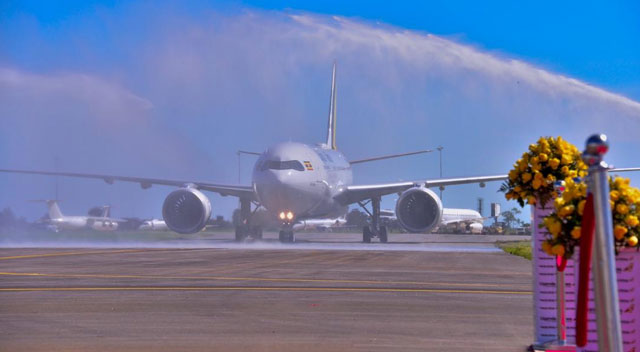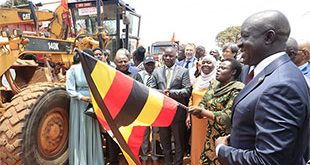
AVIATION DIGEST | JARED KALERA | The country’s flag bearer Uganda Airlines has been revamped after many years of inactivity. After the launch, the airline first chose particular destinations in Africa.
As of September 2021,Uganda Airlines has been doing Nairobi, Mombasa, Dar Es salaam, Kilimanjaro, Zanzibar, Johannesburg, Bujumbura, Mogadishu, Kinsasha and Juba. They recently added the Dubai route.
There have since been talks about flights to China and the United Kingdom. Many must wonder why this spreading of wings takes such a long time to realize and how decisions about where to fly are arrived at.
The decision where to fly is not by wish or chance. Airlines can lose lots of money by going to the wrong destinations. Therefore they use different denominators to decide.
FIRST, they will examine a destination to see how many people are willing to go to a particular destination by air and at what cost. They will also examine if these people can sustain a particular travel routine. Travel Search engines come in handy to show how many search particular destinations compared to actual figures.
For example, the Nairobi Entebbe route is a very busy one with lots of competition and yet one of the most expensive routes . It’s flights especially morning ones are always fully booked. However when Uganda Airlines started, it was one of the first it thought about. Therefore if people are willing to spend and sustain a particular route then that route will be viable.
SECOND, they will look at the available service structures. For example are current players using Hub and Spoke or Point to Point ? Hub and Spoke means different airlines and long haul flights come and feed into a hub. Which means all flights will always have a connection to a particular hub. While point to point means an airline will drop at airports simply because it has demand.
Airlines will normally use the Banked hub approach where all flights arrive and depart at approximately the same time . This airline’s flights will start and stop at that selected hub. This easily helps feeding flights to deliver passengers who will take shorter times while making connecting flights.
However the location of a hub or intended home of an airline matters. For example Nairobi, Entebbe and Addis Ababa have hub operation advantages as compared to Johannesburg. You have more connecting flights from these hubs than Johannesburg which is more of a final destination.
THIRD factor, is the economic activities in a particular destination. Tourist destinations will normally boom during particular seasons while business destinations will always be busy all year round.
The catchment industries are fundamental in decision making. Is it a banking city, is it a mining city,or is it a political capital? All these determine the type of passengers and how willing they are to take flights. Demand and local income factors have to be called into perspective in relation to the political landscape and local Administrative (government approvals) and Tourism players.
For example London, Vienna, Munich, Nairobi, Kinsasha and Entebbe will operate all year round while Mombasa and Zanzibar being tourism destinations may not. This is what is called the seasonality profile of a city.
The FOURTH factor is Equipment. Equipment basically refers to the aircrafts that are available. Each business model requires a particular set of craft. Long haul as opposed to short point to point destinations each use different crafts.
Uganda Airlines for example has the CRJ 900 jets with a range of 2,500kms and the 251 Tonne Airbus A330-800 with a range of 8,150 Nautical miles ( 15,094kms) and 260 passengers depending on the configuration. The CRJ 900 has a capacity of 90 passengers and can be deployed for point to point short flights while the A330-800 can do long haul flights from Entebbe to Guangzhou and Entebbe to Dubai which are 9,080kms and 3,724.02kms respectively.
But the planners of each airline will decide whether to relocate a craft to another route, purchase another (which can take more than a year to be delivered), or lease ( wet or dry lease) one for immediate delivery.
Therefore the speed and ease with which an airline can move around their crafts fundamentally affects the decision to fly to particular destinations.
While these are not conclusive, other factors like ground turn around, availability of slots, set up expenses, labor factors, pandemic prone destinations, over flight fees may or may not affect the decision by an airline where to fly.
*****
Sometimes flying is such a challenge due to planning. What is the best way one can prepare for a flight.
Our next article will delve into the basics.
*******
 Jared is an aviation researcher and trained motor rally safety official. He is the General Manager Legal Compliance and Human Resource, Muttico Technical Services Ltd and co director at Amputee Self Help Network Uganda.
Jared is an aviation researcher and trained motor rally safety official. He is the General Manager Legal Compliance and Human Resource, Muttico Technical Services Ltd and co director at Amputee Self Help Network Uganda.
 The Independent Uganda: You get the Truth we Pay the Price
The Independent Uganda: You get the Truth we Pay the Price



